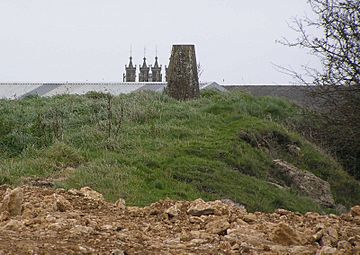Dundry Hill facts for kids
Quick facts for kids Dundry Hill |
|
|---|---|

The Trig point at the top of Dundry Hill with the top of the tower of Church of St Michael, Dundry in the background
|
|
| Highest point | |
| Elevation | 223 m (732 ft) |
| Prominence | 170 m (560 ft) |
| Parent peak | Beacon Batch |
| Listing | Marilyn |
| Geography | |
| Location | North part of the Mendip Hills, England |
| OS grid | ST553667 |
| Topo map | OS Landrangers 172, 182 |
Dundry Hill is a cool place just south of Bristol, England. It's a mix of green farmlands, a few houses, and a really old church. The hill stretches out for about two miles from east to west. Most of Dundry Hill is in an area called North Somerset. But at its eastern end, some parts are in Bath and North East Somerset, and the northern side even reaches into the city of Bristol. In fact, the very highest point in Bristol is right here on Dundry Hill!
The small village of Dundry sits near the top of the hill. It has a church that you can see from far away. At the eastern end of the hill, you'll find Maes Knoll. This is an ancient hillfort from the Iron Age, located near Norton Malreward. It's also where the old earthwork called Wansdyke begins. If you look to the south of the hill, you'll see the beautiful Chew Valley.
On the western side of Dundry Hill, there's a spring. This spring is the starting point for a small river called the Land Yeo.
Dundry Hill's Special Geology
Dundry Hill is known for its interesting rocks and fossils. One particular spot, called Dundry Main Road South Quarry, is very important.
A Site of Special Scientific Interest
Dundry Main Road South Quarry is a special place for geology. It's officially known as a Site of Special Scientific Interest (SSSI). This means it's protected because it has unique natural features. This quarry is about 0.7 hectares in size and is near the village of East Dundry.
Fossils and Ancient Life
The quarry is famous for the many fossils found there. These fossils are in a type of rock called "inferior oolite." This rock layer shows a lot of ancient sea creatures, especially ammonites. Ammonites were like squid living inside a spiral shell, and they lived millions of years ago.
The rocks at Dundry Main Road Quarry show different kinds of fossils. Some are similar to those found in southern England and Normandy, France. Other fossils are like those found in the Cotswolds. This difference helps scientists understand how the land moved and changed during the Middle Jurassic period. It gives us clues about what the Earth looked like a very long time ago.

